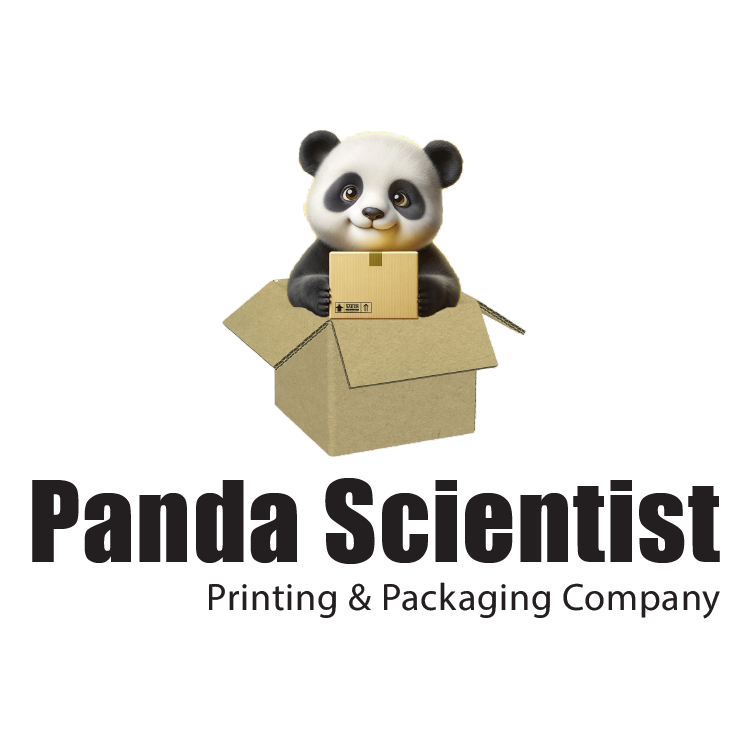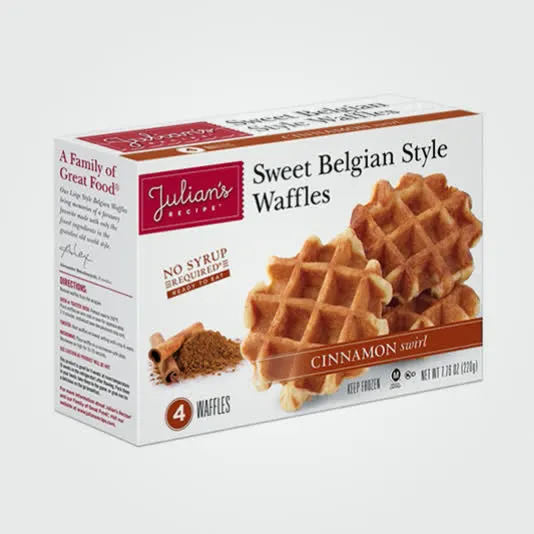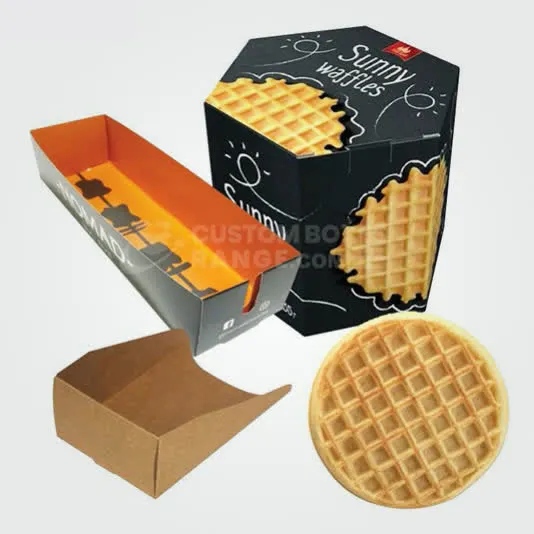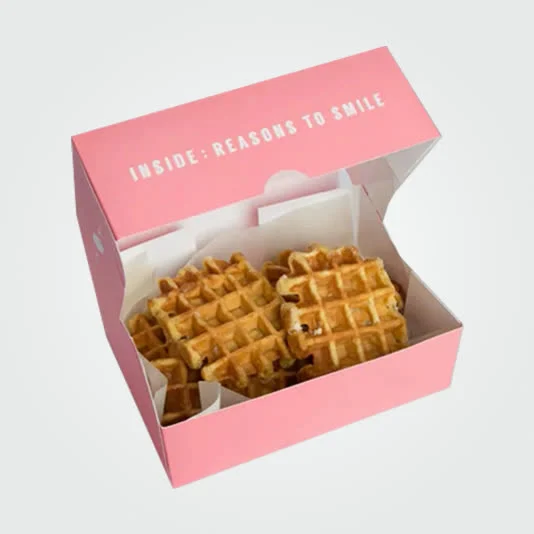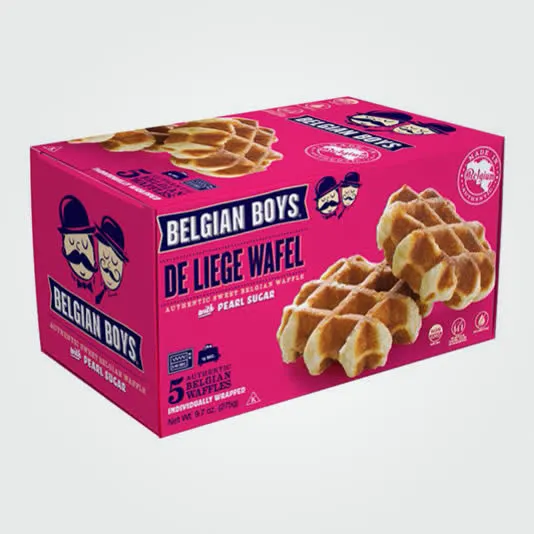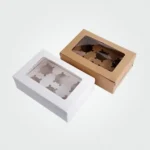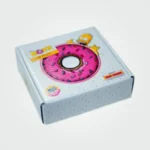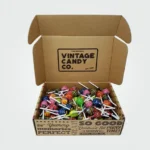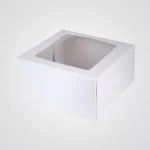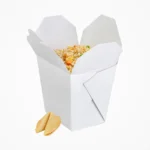Waffle Boxes
Custom Waffle Boxes
Delight in the experience of preserving the delicate crispness and warmth of your waffles with our Custom Waffle Boxes. Specifically crafted to cater to the unique texture and shape of waffles, these boxes ensure that every groove remains intact and every bite as fresh as when first made. Adorned with designs that range from classic breakfast motifs to contemporary chic, they perfectly encapsulate the joy of a waffle meal. The sturdiness of the packaging assures there’s no compromise on the waffle’s integrity, regardless of the journey it undertakes. With our Custom Waffle Boxes, every waffle is not just a treat to the taste buds but also a feast for the eyes, celebrating the union of delectable taste and impeccable presentation.
Market Share and Future of Waffle Boxes in the United States
Estimating the exact market share of waffle boxes in the United States is difficult, as many different packaging materials and solutions are available. However, it is clear that there is a growing demand for sustainable packaging solutions, and waffle boxes are well-positioned to meet this demand. According to a report by Grand View Research, the global sustainable packaging market size was valued at USD 138.94 billion in 2020 and is expected to grow at a compound annual growth rate (CAGR) of 6.8% from 2021 to 2028. This growth is driven by increasing awareness about environmental issues and government regulations and initiatives to reduce plastic waste and promote sustainability.
In the United States, many companies offer waffle boxes and other sustainable packaging solutions. For example, EcoEnclose, a Colorado-based company, offers a range of eco-friendly packaging products, including waffle boxes made from recycled paperboard. Similarly, Packlane, a California-based company, offers customizable waffle boxes that are both sustainable and visually appealing. Looking to the future, the demand for sustainable packaging solutions will likely continue to grow as consumers and businesses become more aware of the environmental impacts of traditional packaging materials. With their eco-friendly properties and unique design, Waffle boxes are well-positioned to meet this demand and become an increasingly popular choice for various products and applications in the United States and beyond.
Short History of Waffle Boxes
The use of corrugated cardboard for packaging dates back to the 1800s, but waffle boxes’ development is a more recent innovation. The waffle pattern in the cardboard provides extra strength and stability to the box, allowing it to withstand heavier loads and rougher handling during transport. The first patent for a waffle box design was filed in 1958 by Vernon G. Cornell, but the boxes didn’t become widely popular until the 1970s. Today, waffle boxes are a common sight in retail packaging, particularly in the food industry. They are famous for shipping and storing perishable items like fruits and vegetables and baked goods like cakes and pies. Waffle boxes are also used for electronics and other delicate items requiring extra transport protection.
The significance of waffle boxes in the retail packaging industry lies in their durability and versatility. They provide excellent product protection during shipping and storage while being accessible to stack and transport. Waffle boxes are also an eco-friendlier packaging option than plastic, as they can be recycled and biodegradable. Overall, waffle boxes have become a staple in the retail packaging industry, and their continued use and development will likely play an essential role in the future of sustainable packaging.
Advantages of Waffle Boxes
Waffle boxes offer several advantages over other types of packaging, including:
Waffle boxes offer several advantages for businesses and consumers alike. They provide excellent protection for products, are customizable to fit a wide range of products, and are an eco-friendly and sustainable packaging option.
Materials Used in Making Waffle Boxes
Waffle boxes are typically made from paperboard, a type of cardboard that is thicker and more durable than regular paper. Several types of paperboards can be used to make waffle boxes, each with unique properties and characteristics.
Solid Bleached Sulfate (SBS) paperboard
This high-quality paperboard is made from virgin wood pulp. It has a bright white color and smooth surface, making it ideal for printing graphics and logos.
Coated Unbleached Kraft (CUK) paperboard
This paperboard is made from unbleached wood pulp and has a natural brown color. It is often used for eco-friendly packaging, as it is biodegradable and recyclable.
Clay-coated news back (CCNB) paperboard
This lightweight paperboard is made from recycled paper fibers. It has a smooth, glossy surface often used for packaging food and beverages.
Recycled paperboard
This paperboard is made from post-consumer recycled paper and is more sustainable than virgin paperboard. It is often less expensive than virgin paperboard and has similar strength and durability.
Comparison of Virgin and Recycled Paperboard
When comparing virgin and recycled paperboard, each has pros and cons. Virgin paperboard is typically more robust and durable, which can be important for products needing extra protection during transport. However, it is also more expensive and less environmentally friendly compared to recycled paperboard. Recycled paperboard is a more sustainable option, as it reduces waste and saves energy and resources in manufacturing. However, it may not be as strong or durable as virgin paperboard.
Several initiatives and certifications are in place to promote sustainable, biodegradable, and eco-friendly practices in the paper industry. For example, the Forest Stewardship Council (FSC) promotes responsible forest management and ensures that paper products are made from sustainable sources. Additionally, the Sustainable Forestry Initiative (SFI) and the Program for the Endorsement of Forest Certification (PEFC) promote sustainable forest management practices and ensure that paper products are made from responsibly sourced materials. Many paper mills also use eco-friendly manufacturing practices, such as using renewable energy sources and minimizing waste and pollution.
Manufacturing Process of Waffle Boxes
The production process for waffle boxes typically involves the following steps:
Raw material preparation
The paperboard is sourced and brought to the manufacturing facility, which is inspected for quality and consistency.
Corrugation
The paperboard is then fed through a corrugating machine, which adds the waffle pattern to the cardboard. The corrugating process involves passing the paperboard between heated rollers with raised flutes that create the characteristic waffle pattern.
Cutting and creasing
After corrugation, the paperboard is cut to the desired size and shape using specialized cutting and creasing machines. The cutting and creasing process involves cutting the paperboard along pre-determined lines and creating creases that allow the box to be folded and assembled.
Printing and finishing
The waffle boxes are then printed with graphics, logos, and other branding using specialized printing machines. The finishing process may also involve coating or lamination to protect the box from moisture and wear.
Machine-based Production Techniques
Machine-based production techniques are the most common method for manufacturing waffle boxes due to their efficiency and speed. These machines are designed to handle large volumes of cardboard and can produce boxes in various sizes and shapes. Hand-made production methods are also used, particularly for small-batch or custom orders. These methods typically involve using specialized tools and equipment to cut, fold, and assemble the boxes by hand.
Quality Control Measures
Quality control measures are critical in manufacturing to ensure the waffle boxes meet the required standards and specifications. Quality control measures may include:
Manufacturers may conduct regular audits and testing to ensure their processes and products meet regulatory requirements and industry standards.
Types of Waffle Boxes
Standard Waffle Boxes
These are the most common waffle boxes in various sizes and shapes. They are often used for packaging food, such as snacks, sandwiches, and burgers.
Bakery Boxes
Bakery boxes are designed specifically for packaging bakery products, such as cakes, pastries, and cupcakes. They come in various sizes and may have special features, such as a window or ventilation holes, to help preserve the freshness of the baked goods.
Window Waffle Boxes
Window waffle boxes are similar to standard ones but have a clear plastic window on one or more sides to allow customers to see the box’s contents. They are often used for packaging food items that need to be displayed, such as pastries or sandwiches.
Handle Waffle Boxes
Handle waffle boxes have a built-in handle or strap that makes it easy to carry the box. They are often used for packaging heavier or bulkier items, such as food trays or party platters.
Stackable Waffle Boxes
Stackable waffle boxes are designed to be stacked on top of one another, which makes them ideal for packaging multiple items or for use in storage and transport. They may have a flat top or be designed with a locking mechanism to keep the boxes securely in place.
Nested Waffle Boxes
Nested waffle boxes are designed to fit inside one another for easy storage and transport. They are often used for packaging items that need to be shipped or stored, such as electronics or small appliances.
Customized Waffle Boxes
Customized waffle boxes can be designed to meet a customer’s specific needs, such as a unique size, shape, or printing design. They may also include additional features, such as handles or windows, to meet specific requirements. Customized waffle boxes are often used by businesses that want to create a unique branding experience for their customers.
Applications of Waffle Boxes
Waffle boxes have a wide range of applications across different industries, including:
Food Packaging
Waffle boxes are commonly used in the food industry for packaging various food items, such as sandwiches, burgers, pizzas, pastries, and cakes. They are often preferred due to their durability, strength, and eco-friendly nature.
Gift Boxes
Waffle boxes are also used for different occasions, such as birthdays, weddings, and holidays. They can be customized to include branding and designs that match the occasion or the theme of the gift.
Storage Containers
Waffle boxes are ideal for storing and organizing various household and office items, such as books, papers, stationery, and small appliances. They can be stacked, nested, or customized to fit specific storage requirements.
Shipping and Transportation Boxes
Waffle boxes are also used to transport various products and goods, such as electronics, cosmetics, and toys. They are designed to provide protection and safety during transit and can be customized to meet specific requirements, such as weight, size, and durability. Waffle boxes are versatile and widely used in different industries for their durability, strength, eco-friendliness, and customization options.
Custom Waffle Boxes A Unique Presentation
Waffle boxes can be customized and branded to create a unique and personalized customer packaging experience. Customization options can include:
Size and Shape:
Depending on the packaged product, waffle boxes can be customized to meet specific size and shape requirements.
Color and Design:
Waffle boxes can be printed with custom colors and designs to match a company’s branding or a specific product. This can include logos, images, and other visual elements.
Window and Ventilation:
Waffle boxes can be designed with windows or ventilation holes to allow customers to see the box’s contents or to help preserve the freshness of the product.
Handles and Straps:
Waffle boxes can be designed with handles or straps to make them easier to carry and transport.
Eco-Friendly Options:
Waffle boxes can be made from eco-friendly materials and printed with environmentally-friendly inks to align with a company’s sustainability goals. Customizing and branding waffle boxes can help businesses create a unique and memorable packaging experience for their customers, increasing brand recognition and customer loyalty.
Design and Graphics Options for Waffle Boxes
Waffle boxes can be customized with various design and graphics options to enhance the overall packaging experience. Some popular design and graphics options include:
Printing Techniques and Finishes for Waffle Boxes
Waffle boxes can be printed using various techniques and finishes to enhance their visual appeal. Some popular printing techniques and finishes include:
Digital printing:
Digital printing offers high-quality and vibrant printing with fast turnaround times, making it an ideal option for small to medium-sized orders.
Flexographic printing:
Flexographic printing is a cost-effective option for large-quantity orders and offers fast printing speeds.
Foil stamping:
Foil stamping can create a metallic or glossy finish on the packaging, adding an element of luxury to the product.
Embossing and debossing:
Embossing and debossing can add a tactile element to the packaging and create a raised or recessed design on the surface.
Market Trends and Future Outlook for Waffle Boxes
Growth in Demand for Sustainable Packaging Solutions: There has been a growing demand for sustainable packaging solutions in recent years due to increased awareness of environmental issues. Waffle boxes, made from eco-friendly materials that can be recycled, align with this trend and are likely to see increased demand.
Expansion of Online Retail and E-commerce Industry
The e-commerce industry has seen significant growth in recent years, which is expected to continue. As more products are shipped directly to customers, the demand for durable and reliable shipping packaging, such as waffle boxes, will likely increase.
Technological Advancements in the Packaging Manufacturing Industry
Packaging has seen significant technological advancements in recent years, including automation and robotics. This has improved efficiency and cost-effectiveness in producing packaging solutions, including waffle boxes. Future Prospects for Waffle Boxes in the Retail Packaging Industry: Waffle boxes are likely to see continued growth in demand in the retail packaging industry due to their durability, sustainability, and customizable nature. As businesses look for unique and personalized packaging solutions to enhance the customer experience, waffle boxes provide a viable option that aligns with sustainability goals.
Challenges and Limitations of Waffle Boxes
While waffle boxes offer many advantages in terms of sustainability, durability, and customization, there are also some limitations and challenges associated with their use.
More Expensive
Waffle boxes can be more expensive than other packaging materials, such as plastic or foam. This cost can be a barrier to entry for businesses looking to adopt more sustainable packaging solutions but operating on tight budgets.
Availability of materials
The availability of paperboard, the primary material used in making waffle boxes, can be limited in some regions. This can result in higher transportation costs and longer lead times for businesses needing these materials.
Storage space
Waffle boxes can take up more storage space than other types of packaging, such as plastic bags or foam containers. This can be a challenge for businesses that have limited storage space.
Compatibility with certain products
Waffle boxes may not be suitable for packaging certain types of products, such as liquids or fragile items. In these cases, alternative packaging solutions may need to be used.
Manufacturing challenges
The manufacturing process for waffle boxes can be more complex than other types of packaging, resulting in longer lead times and increased costs.
Recycling challenges
While waffle boxes are generally recyclable, they may not be accepted by all recycling facilities due to the complexity of the design and the mix of materials used.
Durability
While waffle boxes are generally solid and durable, they may not be suitable for heavy or bulky items. In these cases, businesses may need additional packaging materials, which can increase costs and reduce the sustainability benefits of using waffle boxes.
Moisture resistance
Waffle boxes are not as moisture-resistant as other packaging materials, such as plastic or foam. This can be a challenge for businesses that need to package moisture-sensitive items.
Design limitations
Waffle boxes have a unique design that may not be suitable for all products or branding needs. For example, some businesses may prefer packaging solutions that allow for an entire wrap-around label or a more traditional box shape.
Transport challenges
The unique design of waffle boxes can make them more difficult to stack and transport than other types of packaging. This can result in increased transportation costs and logistics challenges for businesses.
Consumer perception
While waffle boxes are a sustainable and eco-friendly packaging solution, some consumers may not be familiar with this type of packaging or may prefer more traditional packaging options. This can be a challenge for businesses trying to balance sustainability with consumer preferences and expectations.


